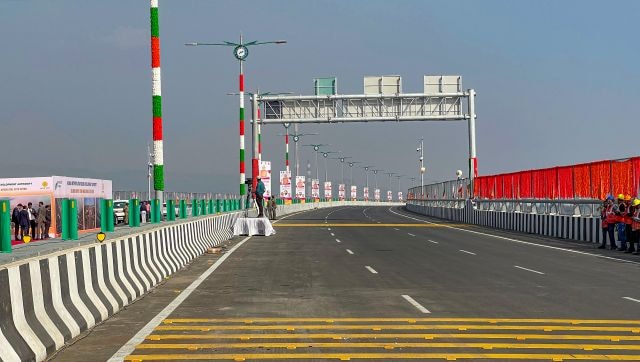Adding one more monumental marvel to India’s infrastructure, Prime Minister Narendra Modi inaugurated the Mumbai Trans Harbour Link (MTHL) today. This 21.8-kilometre-long sea-link connects Mumbai to Navi Mumbai, running from Sewri in Mumbai to Nhava Sheva in the Raigad region. Commencing operations from 13 January, India’s longest bridge, officially named the
Atal Bihari Vajpayee Sewri-Nhava Sheva Atal Setu Sea link , strategically links crucial locations to address Mumbai’s persistent traffic issues. It is said to reduce travel time between Mumbai and Navi Mumbai to around 20 minutes from about two hours. Bridge of possibilities It is a moment to cherish, said senior IAS officer Sanjay Khandare, who helmed the project for four years. Khandare, a 1996 batch IAS officer of Maharashtra cadre, was in charge of the ambitious project, then known as Mumbai Trans Harbour Link, for four years till February 2020, as the then Additional Metropolitan Commissioner of Mumbai Metropolitan Region Development Authority (MMRDA). This is a bridge not just of steel and concrete, but of possibilities. It unlocks new horizons for Mumbai and India, paving the way for economic growth and a brighter future, Khandare, who is now Principal Secretary, Water Supply and Sanitation Department of the state government, told PTI. [caption id=“attachment_13607482” align=“alignnone” width=“640”] Aside from its immediate impact, the bridge helps to cut the distance between the Mumbai and Pune Motorways and acts as an important link to the under-construction Navi Mumbai International Airport. PTI[/caption] I feel very satisfied that I could contribute substantially in the implementation right from approvals, particularly those pertaining to environment and forest departments, as the bridge passes through a very eco-sensitive area having mangroves, a flamingo sanctuary and an important installation like BARC, Khandare said. The senior bureaucrat said work in the initial stages of the project involved dealing with undersea crude lines, land acquisition at both the ends of the sea link, engineering designs and also tendering and execution processes. Daily usage of 70,000 vehicles is expected Atal Setu has been constructed at a total cost of Rs 17,840 crore. It is a six-lane bridge having about 16.5 km length over sea and about 5.5 km on land. The prime minister’s mission is to improve people’s ‘comfort of movement’ by improving urban transport infrastructure and connectivity, and the bridge is in line with this vision. It will enable speedier access to Mumbai International Airport and Navi Mumbai International Airport, as well as shorter travel times between Mumbai and Pune, Goa, and South India. According to the announcement, it will also increase connectivity between Mumbai Port and Jawaharlal Nehru Port. [caption id=“attachment_13607492” align=“alignnone” width=“640”]
 Newly-constructed Atal Bihari Vajpayee Sewri-Nhava Sheva Atal Setu. PTI[/caption] Aside from its immediate impact, the bridge helps to cut the distance between the Mumbai and Pune Motorways and acts as an important link to the under-construction Navi Mumbai International Airport. According to ANI, projections forecast a daily usage of 70,000 vehicles on the bridge. Boost for markets The Atal Setu is expected to boost the Navi Mumbai property markets since the connectivity will result in an increase in real estate activity, demand, and prices. The Mumbai Trans Harbour Link is revolutionary! As a proud Mumbai developer, I see this technical marvel altering our city’s connectivity and real estate landscape. With travel times reduced to 20 minutes between Mumbai and Navi Mumbai, places such as Panvel and Ulwe would experience rapid growth. “We expect a surge in demand for homes driven by professionals looking for affordable luxury close to prime business hubs,” Manju Yagnik, Vice Chairperson of Nahar Group and Senior Vice President of NAREDCO- Maharashtra, told LiveMint. According to experts, the entire region’s property market will benefit, but the influence will be seen most strongly in micromarkets such as Panvel, Ulwe, and Dronagiri, which will have direct access to the bridge. According to them, various factors, including increased connectivity, are projected to drive up property values in Navi Mumbai over the next three years, reports Money Control. With inputs from PTI
Newly-constructed Atal Bihari Vajpayee Sewri-Nhava Sheva Atal Setu. PTI[/caption] Aside from its immediate impact, the bridge helps to cut the distance between the Mumbai and Pune Motorways and acts as an important link to the under-construction Navi Mumbai International Airport. According to ANI, projections forecast a daily usage of 70,000 vehicles on the bridge. Boost for markets The Atal Setu is expected to boost the Navi Mumbai property markets since the connectivity will result in an increase in real estate activity, demand, and prices. The Mumbai Trans Harbour Link is revolutionary! As a proud Mumbai developer, I see this technical marvel altering our city’s connectivity and real estate landscape. With travel times reduced to 20 minutes between Mumbai and Navi Mumbai, places such as Panvel and Ulwe would experience rapid growth. “We expect a surge in demand for homes driven by professionals looking for affordable luxury close to prime business hubs,” Manju Yagnik, Vice Chairperson of Nahar Group and Senior Vice President of NAREDCO- Maharashtra, told LiveMint. According to experts, the entire region’s property market will benefit, but the influence will be seen most strongly in micromarkets such as Panvel, Ulwe, and Dronagiri, which will have direct access to the bridge. According to them, various factors, including increased connectivity, are projected to drive up property values in Navi Mumbai over the next three years, reports Money Control. With inputs from PTI
This is a bridge not just of steel and concrete, but of possibilities. It unlocks new horizons for Mumbai and India, paving the way for economic growth and a brighter future, said senior IAS officer Sanjay Khandare, who helmed the Mumbai Trans Harbour link project for four years
Advertisement
End of Article


)

)
)
)
)
)
)
)
)



